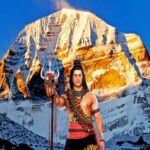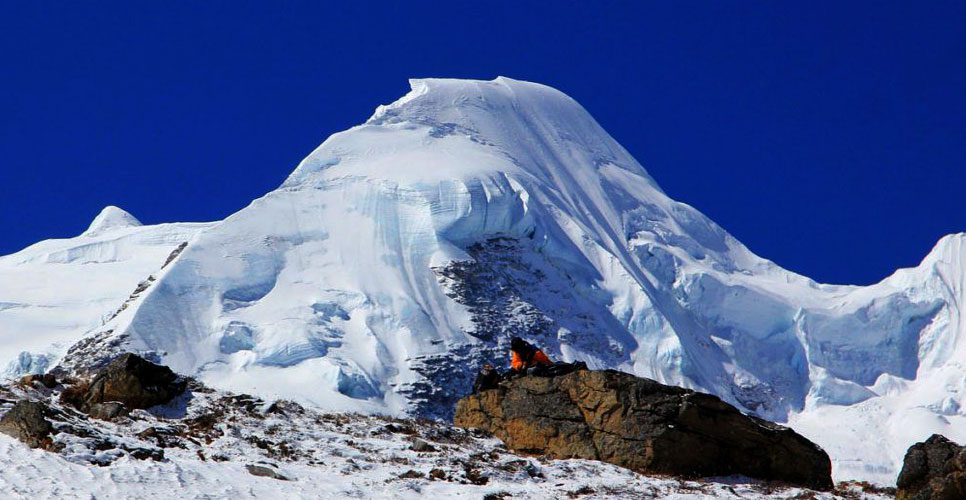18 days Mera Peak Climbing
- Instant Online Booking
- Privacy Protected
- Guranteed Departure
- Group Discount Available
- Best Price Guaranteed
- Options Available (Accommodation, meals, permit fees, ground transportation, government tax, guide, airport picks up & drop off)
18 days Mera Peak Climbing highlight
- 18 days Mera Peak (6654m) is a climbing Peak in Nepal.
- Breathtaking views of Everest, Kanchenjunga, Makalu, Cho Oyu, and Lhotse (over 8000m).
- Mera Peak Climb through unspoiled valleys of the Khumbu region.
- Beautiful Lakes and streams in the Sagarmatha National Park.
- Exciting and adventurous climbing trip.
Most Asked Questions by Travellers
The summit of Mera Peak elevates to 6,189 meters. The climb to the summit of Mera Peak has been considered moderately challenging. Most climbers making it to Mera Peak are beginners and consider this peak their first step towards climbing.
Many climbers take Mera Peak as a training peak for climbing higher mountains like Everest, Annapurna, and Makalu. So, yes, a Mera Peak can be perfect for beginners.
Unlike other mountains or peak climbing in Nepal, the traverse to the summit of Mera Peak is straightforward. The Mera Peak climb is free of steep technical climbs with few problematic stretches. Among other peaks, the upgrade to Mera Peak is considered non-technical. That being said, the elevation of this peak reaches 6461 meters, which makes it prone to AMS.
The usual packaged trip to Mera Peak is at least 21 days. This includes your time in Kathmandu, trekking days, acclimatization days, and climbing period. The actual base camp climb to the Mera Peak summit takes about 5-6 hours. The descent from the panel to the base camp takes about 3 hours. Usually, climber begin their ascent at 2 am and turn around by 10 am.
Professional registered mountain guides are mandatory for any mountain climbing activities in Nepal. As mandated by the Government of Nepal, you are only allowed to climb mountains or peaks of Nepal if accompanied by a registered Travel company and a licensed mountain guide. Thus, you can only climb Mera Peak with a guide.
While beginners are encouraged to try Mera Peak, it is not easy. The sheer altitude of the Mera peak, beyond 6000 meters, makes climbing hard. There are other peaks like Yala Peak (5,700m/18,700ft), Chulu Far-Eastern Peak (6,060m/19,882ft), Chulu West (6,419m/21,055ft), and Pokalde Peak (5,806 m 19,049 ft) that are easier in comparison to Mera Peak.
Mera and Island Peak are both located in the Everest region. They are considered beginner peaks for anyone starting their climbing adventure. Climbers agree that Mera Peak is more accessible than Island Peak on technical grounds.
The technicality of Island Peak is demanding as it requires steep ice climbs, which is different from Mera. Furthermore, narrow rocky ridges, several icefalls, and glacial walks make Island Peak harder than Mera Peak. Thus, the Mera Peak is relatively more manageable than the Island Peak climbing.
Yes, on a clear day, Mt.Everest is distinctly visible from the summit of Mera Peak. Additionally, the view from the top of Mera Peak provides an astounding vista of Cho-Oyu (8201m), Lhotse (8516m), Makalu (8463m), Kanchenjunga (8586m), Nuptse (7855m) and Chamlang (7319m).
Nepal Mountaineering Association has secluded 27 peaks of Nepal as trekking peaks. These peaks, including Mera Peak, have elevation within a range of 5800m – 6476m above sea level. These peaks can be completed with essential trekking experience with proper guidance. Beginner peaks that require novice experience are called trekking peaks.
Yes, Mera Peak is the highest trekking peak in Nepal. It measures 6476 meters above sea level.
Past evidence suggests a 60-70% success rate in Mera Peak Climbing.
There are three different types of accommodation for your Mera Peak Climb. During your stay in Kathmandu, you will have full-fledged luxurious accommodations. During your trekking days, until you reach the base camp, you will stay in teahouses dotted along the trail. You will have tented accommodation at the base camp until you descend.
Since climbing is an arduous adventure, it is required for you to be in the best physical shape. Preparation for Mera Peak must be done at least three months before your climbing date. Your exercise should focus on building good core and leg strength. Also, endurance training is recommended for the climb.
Yes, you need to obtain a climbing permit to climb any peaks in Nepal. A registered trekking company provides you with climbing permits in Kathmandu. Similarly, Climbing guides are compulsory to attain a climbing permit in Nepal. Also required are the Sagarmatha National Park permit and Khumbu Pasang Lhamu Rural Municipality Permit.
Mera Peak is a Himalayan mountain that scales higher than Mt. Kilimanjaro. The traverse to Kilimanjaro is almost similar to that of Mt.Mera. The difficulty of these mountains is practically identical despite Mera being more elevated in elevation.
No way, Mera Peak is a small, petty mountain compared to Mt.Everest. Everest climbing is an expedition that takes over two months to reach the summit, while Mera can be summated within a day from Base Camp and return to Khare.
Mera Peak is located in the eastern highlands of Nepal. It sits facing the mighty Everest range and is nestled in Makalu Barun National Park.
The best time to climb Mera Peak is during spring and autumn. These two seasons provide the best weather window for climbing.
Reviews on 18 days Mera Peak Climbing
5
Based on
390 Reviews

Austria

Mera peak climbing was extraordinary
We have had the great pleasure of joining Mera Peak climbing with my best adventure partner, the Boundless Team. As a nature lover and adventure seeker, I always travel throughout the country solo and always try something new to experience.
I have trekked to various destinations in Nepal, all with one and only Boundless Adventure. Even though I always travel solo, I enjoy the company of others, too. That’s why Mr.Dambar from Boundless Adventure always mixes me with other teams. The fifteen days of Mera peak climbing was extraordinary. The journey started with a flight to Lukla and a trek to Paiya.
With the stunning scenery of the Everest region, I reached Mera Base Camp on the ninth day, including one acclimatization day during the journey. The tenth day leads us to high camp and the eleventh of Mera Peak. Upon reaching the peak, Mount Everest, Cho Oyu, Lhotse, Lhotse Shar, Baruntse, and Makalu surrounded me. I would choose Boundless Adventure again and again without any hesitation.
Anton Zimmermann, Austria

New York

I highly recommend Boundless Team to climbing Mera Peak
Climbing to Mera Peak was not a joke indeed. Walking on rough trails with rocky and icy paths, unpredictable, harsh weather conditions, and technical climbing was challenging. But I had Boundless Adventure’s team by my side. Having such an expert and highly dedicated team who ensure our safety and ensure our enjoyment leads you to success.
Boundless Adventure managed all our logistics without worrying; we just focused on our climbing. The locals along the trail were hospitable and kind. The beautiful scenery in the background never lets us feel tired. Boundless Adventure managed simple yet comfortable accommodation for us. Overcoming the technical part of the climb with our expert guide takes us to the magnificent scenery of the Himalayas. I highly recommend Boundless Team for any adventure enthusiast.
Ethan Taylor, New York City

France

Climb Mera Peak on second anniversary
We chose Boundless Adventure as our support partner for our climbing journey to Mera Peak, which became one of the best decisions. My wife and I are both adventure seekers, and on our second anniversary, we planned to climb the technical peak in Nepal and decided to choose Mera Peak. We contacted Boundless Adventure through WhatsApp. Their instant response, itinerary plan, and reasonable price attracted us. We had a great time climbing Mera Peak with Boundless Adventure.
The way team members cared for us and made my wife comfortable is appreciated. The journey was equally admirable. The beauty of the Everest region was nothing sort of heaven. Some climbing parts were adventurous, but our guide helped us with each step. We have decided to choose Boundless Adventure for our upcoming adventure in Nepal. Also, we highly recommend the company to anyone looking for a safe and delightful journey in Nepal.
Caleb and Cantola, France
























